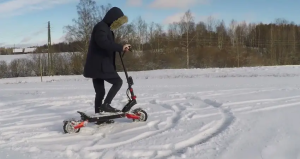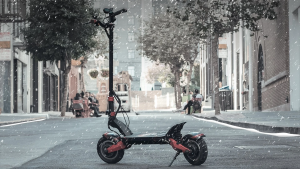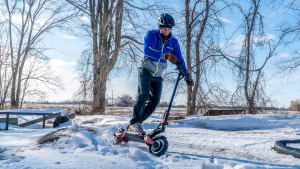Yes, you can ride an electric scooter in snow, but it requires special preparations and techniques for safety.
Assessing the Safety of Electric Scooters in Snowy Conditions
Electric scooters, a popular mode of urban transportation, face unique challenges when operated in snowy conditions. Assessing their safety involves examining various factors such as traction, visibility, and the impact of cold temperatures on scooter performance.
Traction and Stability on Snowy Surfaces
Traction is critical for electric scooter safety in snow. Scooters typically have smaller tires than other vehicles, which can compromise their grip on snowy or icy surfaces. Manufacturers may offer models with larger tires or even tires specifically designed for winter conditions, featuring deeper treads for improved grip. Riders should consider the tire specifications, such as the size, which usually ranges from 8 to 10 inches in diameter, and tread patterns that enhance stability.
Adding to the stability issue is the scooter’s center of gravity. Electric scooters with a lower center of gravity can offer better stability on slippery surfaces. The weight distribution, influenced by both the scooter’s design and the rider’s position, also plays a significant role. Scooters with a heavier rear, where the motor is often located, can provide better traction during acceleration.
Visibility Concerns During Snowfall
Visibility is a major safety concern during snowfall. Reduced visibility can affect a rider’s ability to see obstacles, and equally, it can affect how well other road users can see the scooter. High-quality lighting is essential – both front and rear lights. LED lights are commonly used for their efficiency and brightness. Additionally, reflective materials on the scooter and the rider’s clothing can significantly enhance visibility.
Snowfall can also lead to the accumulation of snow on the scooter’s headlight and taillight. Regularly clearing this snow is crucial to maintain visibility. The use of anti-fog sprays or wipes on the lights can help prevent the build-up of snow and ice.
Impact of Cold Temperatures on Scooter Performance
Cold temperatures can significantly affect electric scooter performance, especially concerning battery life. Lithium-ion batteries, widely used in electric scooters, can lose up to 20% of their efficiency in cold weather. This loss in efficiency not only reduces the range of the scooter but also its power output, which can impact acceleration and hill-climbing abilities.
Preparations for Riding Electric Scooters in Snow
Proper preparation is essential for safely riding electric scooters in snowy conditions. This involves equipping the scooter with necessary gear and performing thorough pre-ride checks.
Necessary Equipment and Accessories
Choosing the right equipment and accessories enhances both safety and performance of electric scooters in snow. Key items include:
Winter Tires: Select tires designed for snow and ice. They typically range in cost from $30 to $100 per tire, depending on quality and brand.
Anti-Slip Grip Tape: Enhance foot traction on the scooter deck. This tape can be found for around $10 to $20.
Headlights and Taillights: LED lights are preferable for their brightness and efficiency. A good set can cost between $15 and $50.
Reflective Clothing: High-visibility jackets or vests increase rider visibility, usually priced at $20 to $100.
Hand Warmers: For comfort and better grip control. Reusable hand warmers can cost around $15 to $30.
Pre-Ride Safety Checks and Adjustments
Performing pre-ride safety checks is crucial to ensure the scooter is in optimal condition for snowy rides:
- Battery Check: Ensure the battery is fully charged. The average electric scooter battery lasts for 1-3 years, depending on usage and maintenance, and costs between $100 and $300 for a replacement.
- Brake Inspection: Check that the brakes are responsive. Brake maintenance kits range from $15 to $50.
- Tire Pressure: Correct tire pressure, usually around 40-60 PSI for electric scooters, is vital for good traction.
- Light Functionality: Verify that all lights are working and visible.
- Control Mechanisms: Ensure that the throttle and handlebars operate smoothly.
Techniques for Maneuvering Electric Scooters on Snowy Roads
Riding an electric scooter on snowy roads requires specific techniques for balancing, control, braking, and turning. These skills are crucial for safe navigation in slippery conditions.
Balancing and Control in Slippery Conditions
Maintaining balance and control on an electric scooter when roads are slippery is challenging but manageable with the right approach.
- Lower Your Center of Gravity: Bending your knees slightly and leaning forward slightly can significantly improve balance. This position distributes your weight more evenly across the scooter, enhancing stability.
- Gradual Acceleration: Avoid rapid acceleration. Electric scooters, especially those with higher power outputs (ranging from 250 to 1000 watts), can easily lose traction when accelerating too quickly on snowy surfaces.
- Stay Relaxed: Tense muscles can lead to overreactions. Keeping your body relaxed allows for smoother adjustments to the scooter’s movements.
- Use Both Feet: In extremely slippery conditions, placing one foot on the ground for additional support can help maintain balance.
Braking and Turning on Snow-Covered Surfaces
Braking and turning on snow-covered surfaces demand careful and precise actions to prevent slips and falls.
- Gentle Braking: Apply the brakes softly and gradually. Abrupt braking can cause the wheels to lock and lead to skidding.
- Lean into Turns: Gently lean your body into the direction of the turn while maintaining a steady speed. This technique helps in maintaining traction.
- Avoid Sharp Turns: Make wider, more gradual turns to reduce the risk of slipping. Sharp turns can easily lead to loss of control on icy surfaces.
- Awareness of Speed: Maintaining a moderate speed, typically around 5 to 10 mph, depending on the scooter’s capacity and the road condition, is crucial. Faster speeds make it more difficult to react in time if you encounter a patch of ice or deep snow.
Maintenance and Care of Electric Scooters in Winter Conditions
Proper maintenance and care of electric scooters during the winter are crucial for their longevity and performance. Cold weather presents unique challenges, requiring specific attention to cleaning, storage, and battery care.
Cleaning and Storage Post-Ride
Ensuring your scooter is clean and properly stored after use in winter conditions is vital for its upkeep.
Thorough Cleaning: Always clean your scooter after a ride in the snow. Salt and de-icing chemicals can corrode metal parts. Use a damp cloth to wipe down the scooter, paying special attention to the undercarriage and any metal components.
Dry Before Storage: Make sure the scooter is completely dry before storing it. This prevents rust and corrosion. If possible, use a microfiber cloth or an air blower to remove moisture from hard-to-reach areas.
Proper Storage Location: Store your scooter in a dry, warm place. Extreme cold can damage the battery and electronic components. Ideally, the storage temperature should be above freezing.
Battery Care and Charging in Cold Weather
Battery maintenance in cold weather is crucial as low temperatures can significantly affect battery performance and lifespan.
Room Temperature Charging: Always charge the battery at room temperature. Charging a cold battery (especially lithium-ion) can cause permanent damage. If your scooter has been in the cold, let it warm up to room temperature before charging.
Regular Charging: Keep the battery charged even when the scooter is not in use. A battery left discharged for extended periods can lose its ability to hold a charge.
Battery Insulation: Consider using battery insulation covers if your scooter is exposed to cold temperatures for extended periods. These covers can help maintain battery temperature, especially in scooters with batteries that have lower power outputs (250 to 500 watts).
Real-Life Experiences and Tips
Drawing from the experiences of those who have navigated snowy conditions on electric scooters can provide valuable insights and practical advice.
Stories from Riders Who’ve Navigated Snow
Real-life stories from riders offer a glimpse into the challenges and joys of riding in the snow.
- Many riders emphasize the importance of appropriate gear and pre-ride checks. Stories often highlight instances where thorough preparation made a significant difference in handling unexpected snowy patches.
- Experiences with different scooter models provide insights into which types of scooters perform best in snowy conditions. Higher-powered scooters (500 watts and above) are often favored for better traction and control.
Practical Advice for New and Experienced Riders
Seasoned riders often have a wealth of knowledge to share, beneficial for both new and experienced scooter enthusiasts.
Start Slowly: If you’re new to riding in snow, start with short trips on familiar roads to get a feel for how your scooter handles different types of snowy surfaces.
Avoid Deep Snow: Riding in deep snow can bog down the scooter and potentially damage the electrical systems.
Learn from Mistakes: Every slip or challenge is an opportunity to learn. Adjust your riding style and preparations based on past experiences.




